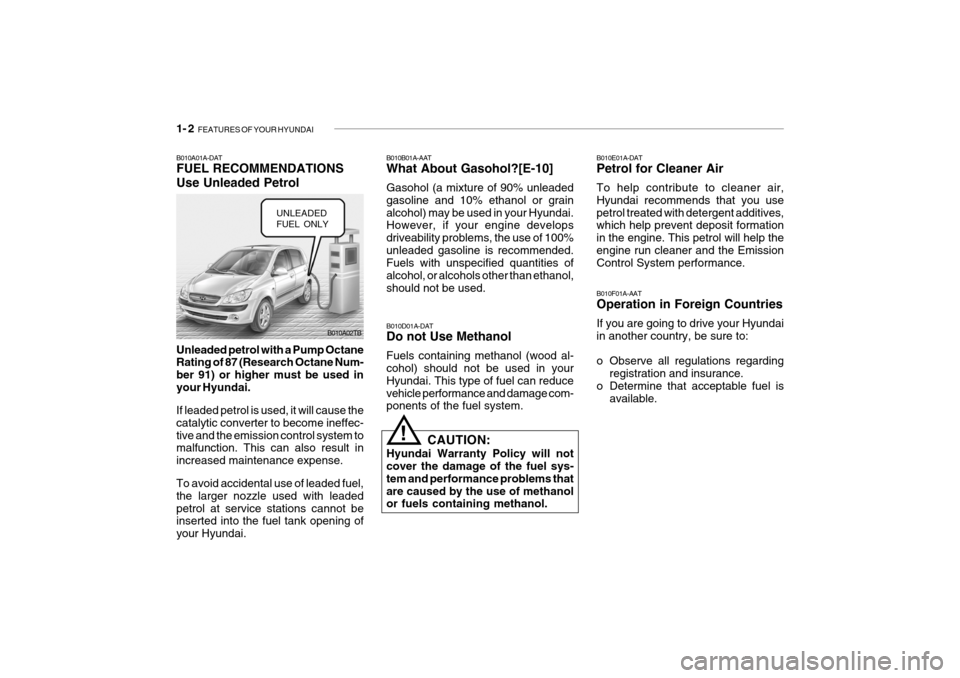open gas tank Hyundai Getz 2009 Owner's Manual - RHD (UK, Australia)
[x] Cancel search | Manufacturer: HYUNDAI, Model Year: 2009, Model line: Getz, Model: Hyundai Getz 2009Pages: 191, PDF Size: 6.3 MB
Page 13 of 191

1- 2 FEATURES OF YOUR HYUNDAI
B010F01A-AAT Operation in Foreign Countries If you are going to drive your Hyundai in another country, be sure to:
o Observe all regulations regarding
registration and insurance.
o Determine that acceptable fuel is available.
Unleaded petrol with a Pump Octane Rating of 87 (Research Octane Num- ber 91) or higher must be used inyour Hyundai. If leaded petrol is used, it will cause the catalytic converter to become ineffec-tive and the emission control system to malfunction. This can also result in increased maintenance expense. To avoid accidental use of leaded fuel, the larger nozzle used with leadedpetrol at service stations cannot be inserted into the fuel tank opening of your Hyundai.
B010A01A-DAT FUEL RECOMMENDATIONS Use Unleaded Petrol
B010A02TB B010E01A-DAT Petrol for Cleaner Air To help contribute to cleaner air, Hyundai recommends that you usepetrol treated with detergent additives, which help prevent deposit formation in the engine. This petrol will help theengine run cleaner and the Emission Control System performance.
B010D01A-DAT Do not Use Methanol Fuels containing methanol (wood al- cohol) should not be used in your Hyundai. This type of fuel can reducevehicle performance and damage com- ponents of the fuel system.
! CAUTION:
Hyundai Warranty Policy will not cover the damage of the fuel sys- tem and performance problems thatare caused by the use of methanol or fuels containing methanol.
UNLEADED FUEL ONLY
B010B01A-AAT What About Gasohol?[E-10] Gasohol (a mixture of 90% unleaded gasoline and 10% ethanol or grainalcohol) may be used in your Hyundai. However, if your engine develops driveability problems, the use of 100%unleaded gasoline is recommended. Fuels with unspecified quantities of alcohol, or alcohols other than ethanol,should not be used.
Page 175 of 191

7- 2 EMISSION CONTROL SYSTEMS
H010A01A-DAT
EMISSION CONTROL SYSTEM (If Installed)
Your Hyundai is equipped with an
emission control system to meet all ADR requirements. There are three emission control sys-
tems which are as follows.
1. Crankcase emission control sys- tem
2. Evaporative emission control sys- tem
3. Exhaust emission control system
In order to assure the proper function
of the emission control systems, it is recommended that you have your car inspected and maintained by anauthorised Hyundai dealer in accor- dance with the maintenance sched- ule in this manual. H010B01A-AAT
1. Crankcase Emission Control
System
The positive crankcase ventilation
system is employed to prevent airpollution caused by blow-by gases being emitted from the crankcase. This system supplies fresh air to thecrankcase through the air intake hose. Inside the crankcase, the fresh air mixes with blow-by gases, which thenpass through the PCV valve and into the induction system.
H010C01A-DAT
2. Evaporative Emission
Control System (If Installed)
The Evaporative Emission Control
System is designed to prevent fuel vapors from escaping into the atmo- sphere. H010D01A-DAT
3. Exhaust Emission Control
System
This system has been integrated intoa highly effective system which con- trols exhaust emissions while main-taining good vehicle performance.
Canister
While the engine is inoperative, fuel
vapors generated inside the fuel tankare absorbed and stored in the canis-ter. When the engine is running, the fuel vapors absorbed in the canister are drawn into the induction systemthrough the purge control solenoid valve. Purge Control Solenoid Valve
The purge control solenoid valve is
controlled by the ECU; when the en- gine coolant temperature is low, and during idling, it closes, so that evapo- rated fuel is not taken into the engine.After engine warm-up, during ordi- nary driving, it opens so as to intro- duce evaporated fuel to the engine.